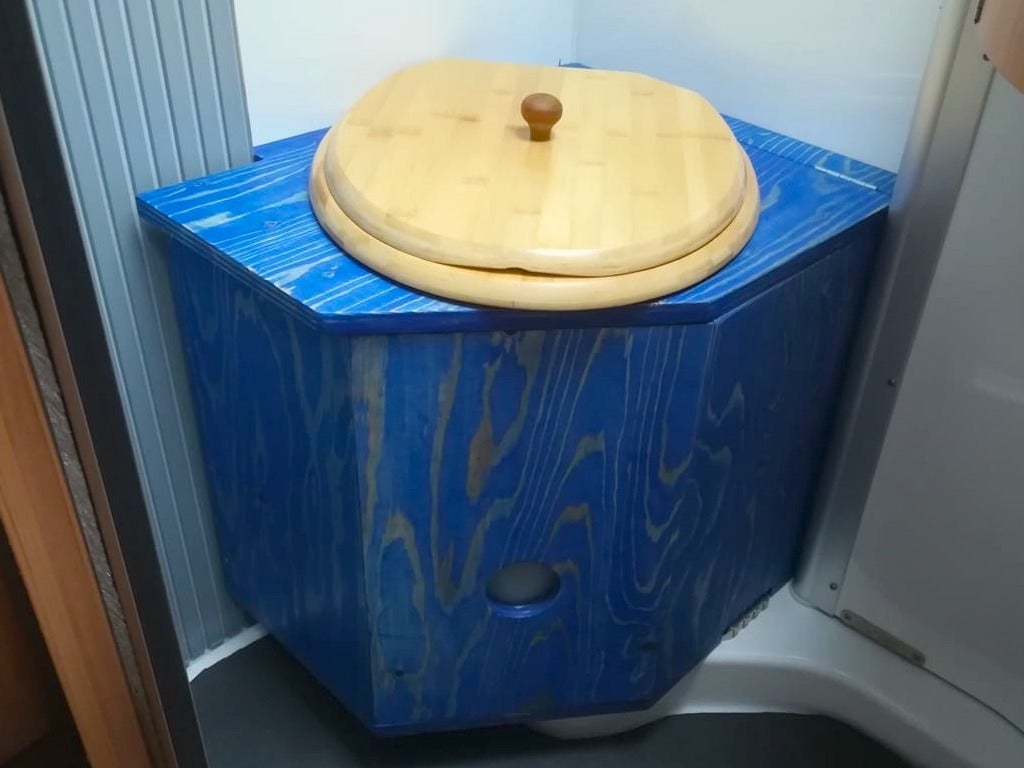
Self-build dry composting toilet in the Pössl
Share

Thomas provided us with this self-built dry separation toilet.
He drives a Pössl motorhome and the separation toilet should fit in the wet cell. The space provided for it is very cramped. Building the dry toilet was a challenge.

Self-build dry separation toilet - Material
- Separett Privy 400 XS (no longer available -> alternative!)
- 10 l urine canister
- 16.6 l solids container
- Bamboo toilet seat from the hardware store
- Wood for body
- Template
Situation in the Pössl
Thomas writes the following about the approach to building the dry separation toilet himself: In our van, the space for the toilet is very tight, as there is a swing wall in the bathroom that covers the toilet and washbasin if necessary and conjures up a shower with fixed walls.
So I spent a long time fiddling with cardboard templates to see if a dividing toilet was even feasible.
Here are some do-it-yourself kits that you can use to build a separation toilet yourself
Oder: Alle Selbstbau-Sets ansehen
Building instruction dry toilet
Thomas continues: "Then I took the step and, with a heavy heart, removed the existing cassette toilet, measured it again and started building the body.
From "MeineTrenntoilette.de" I then ordered the Privy 400 XS separet, a 10-litre canister and a 16-litre solids bucket. The toilet seat and lid are made of bamboo (DIY store).
Because of the lack of space, the hinge mechanism had to give way here. The seat is now attached directly to the body, but not firmly, so that everything can be cleaned easily. The lid lies loosely on top and is protected from slipping with dowels.
Solution despite lack of space
In order to maintain optimum seating comfort despite the small dimensions and to be able to use a 10-litre canister, I opted for the removable lid, which can be conveniently placed to the right or left of the seat when in use.
Note: Good idea when space is tight, much like our Trelino L.


Personal experience
Thomas' first experiences with the separation toilet were good.
He writes: The urine canister has to be emptied after about 3 days, the solids bucket was full after 4 days at the latest (use by 2 adults).
As there were smells, we filled up very generously with litter (wood shavings and sawdust), which explains why the bucket was full so quickly.
Finally, I added a 40 mm PC fan that blows through the service door into a SOG enclosure. The fan can only be heard when you press your ear against the outside of the flap.
The consumption is 0.45 watts. We plan to run the fan permanently when we are travelling by bus. We still lack the relevant experience here.
However, I expect that the emptying intervals of the bucket will now be significantly longer and the odour will be minimised. Compared to the Dometic toilet, which weighed 10.8 kg, the new separation toilet is a little lighter at 9.3 kg.
For me, the main reasons for changing are the greater freedom due to longer emptying intervals and water savings, as well as easier disposal.

Conclusion
Even in the smallest of spaces, a self-build dry separation toilet with standard containers can find room. A template brought light into the darkness.
A little ingenuity and creativity are certainly not insignificant. But if you don't have that, you'll find plenty of ideas and suggestions for implementation here on our blog in the DIY reports.
You can also find a lot of exchange on Facebook in the Separating Toilets group. Why don't you take a look?